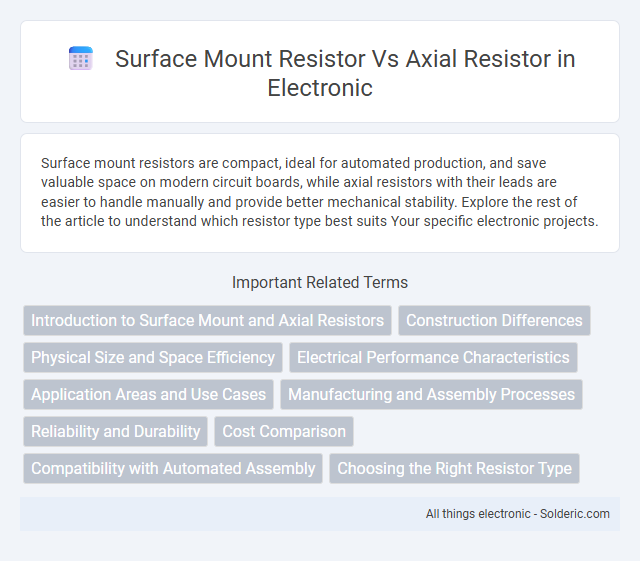Surface mount resistors are compact, ideal for automated production, and save valuable space on modern circuit boards, while axial resistors with their leads are easier to handle manually and provide better mechanical stability. Explore the rest of the article to understand which resistor type best suits Your specific electronic projects.
Comparison Table
| Feature | Surface Mount Resistor (SMD) | Axial Resistor |
|---|---|---|
| Mounting Type | Surface mount on PCB | Through-hole on PCB |
| Size | Compact, small footprint (e.g., 0603, 0805) | Larger, cylindrical body with leads |
| Power Rating | Typically 0.1W to 0.5W | Typically 0.25W to 2W or higher |
| Installation | Automated pick-and-place compatible | Manual or wave soldering |
| Performance | Lower parasitic inductance and capacitance | Higher parasitic inductance; suitable for high power |
| Manufacturing Cost | Lower for mass production | Higher due to manual handling |
| Applications | Consumer electronics, high-density PCB | Power electronics, high-reliability circuits |
| Reliability | Sensitive to mechanical stress | Robust, tolerant to mechanical strain |
Introduction to Surface Mount and Axial Resistors
Surface mount resistors are compact, rectangular components designed for automated placement on printed circuit boards (PCBs), offering high-density circuit integration and improved performance at high frequencies. Axial resistors feature a cylindrical body with leads extending from both ends, ideal for through-hole mounting and mechanical stability in traditional circuit designs. Both resistor types serve essential roles in electronic circuits, with surface mount resistors favored for miniaturization and axial resistors preferred for prototyping and applications requiring robust mechanical support.
Construction Differences
Surface mount resistors consist of a compact ceramic substrate with a thin-film or thick-film resistive element deposited on its surface, allowing for minimal space usage on a circuit board. Axial resistors feature a cylindrical ceramic or metal oxide body with wire leads extending from both ends, designed for through-hole mounting. Understanding these construction differences helps optimize your circuit design for size, heat dissipation, and mechanical stability.
Physical Size and Space Efficiency
Surface mount resistors feature a compact, flat design typically ranging from 0201 to 2512 in size codes, allowing for high-density circuit assembly and significant space savings on PCBs. Axial resistors are larger cylindrical components with leads extending from both ends, occupying more board space and limiting the component density achievable in designs. The reduced footprint of surface mount resistors enhances layout flexibility and is ideal for modern miniaturized electronic devices requiring efficient use of physical space.
Electrical Performance Characteristics
Surface mount resistors offer superior high-frequency performance and lower parasitic inductance compared to axial resistors, making them ideal for compact, high-speed circuits. Axial resistors, while bulkier, typically provide better power dissipation and thermal stability in lower-frequency, higher-power applications. Your choice between the two should consider the specific electrical performance requirements of your circuit design.
Application Areas and Use Cases
Surface mount resistors are primarily used in compact, high-density electronic devices such as smartphones, laptops, and automotive control systems due to their small size and compatibility with automated assembly processes. Axial resistors are commonly found in applications requiring higher power dissipation and robustness, including power supplies, audio equipment, and industrial machinery where manual assembly or repair is frequent. The choice between surface mount and axial resistors depends on factors like board space constraints, power rating, and manufacturing methods.
Manufacturing and Assembly Processes
Surface mount resistors are designed for automated pick-and-place machines, enabling faster and more precise assembly on printed circuit boards (PCBs) with reflow soldering, which improves production efficiency and reduces labor costs. Axial resistors require through-hole mounting, involving manual or wave soldering processes that are slower and less compatible with high-density circuit designs. The manufacturing process for surface mount resistors favors miniaturization and mass production, while axial resistors are better suited for simple, low-volume, or prototype assemblies.
Reliability and Durability
Surface mount resistors demonstrate higher reliability and durability due to their smaller size and reduced susceptibility to mechanical stress, vibration, and thermal cycling compared to axial resistors. The low profile and solder joint configuration of surface mount resistors enhance their resistance to environmental factors such as moisture and corrosion. Axial resistors, while robust for certain applications, are more prone to failure from physical damage and lead fatigue, making surface mount resistors the preferred choice for high-reliability, long-life electronic assemblies.
Cost Comparison
Surface mount resistors typically offer lower manufacturing and assembly costs due to automated placement and smaller size, which reduces material usage and board space. Axial resistors incur higher labor and handling expenses because they often require manual insertion and larger PCB footprints. The overall cost advantage usually favors surface mount resistors in high-volume production environments.
Compatibility with Automated Assembly
Surface mount resistors offer superior compatibility with automated assembly processes due to their compact size and standardized packaging, enabling rapid placement by pick-and-place machines on printed circuit boards (PCBs). Axial resistors, with their extended leads and larger form factor, often require manual insertion or specialized equipment, resulting in slower throughput and increased labor costs. The trend towards surface mount technology (SMT) aligns with industry demands for higher production efficiency and miniaturized electronic devices.
Choosing the Right Resistor Type
Choosing the right resistor type depends on your circuit's size constraints and performance requirements. Surface mount resistors offer compact size, excellent high-frequency performance, and automated assembly compatibility, making them ideal for modern, compact PCBs. Axial resistors provide easier manual handling and higher power ratings, preferred for prototyping or applications needing robust tolerance to mechanical stress.
Surface mount resistor vs axial resistor Infographic

 solderic.com
solderic.com